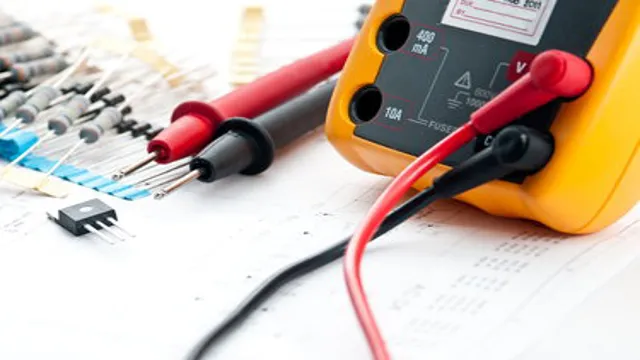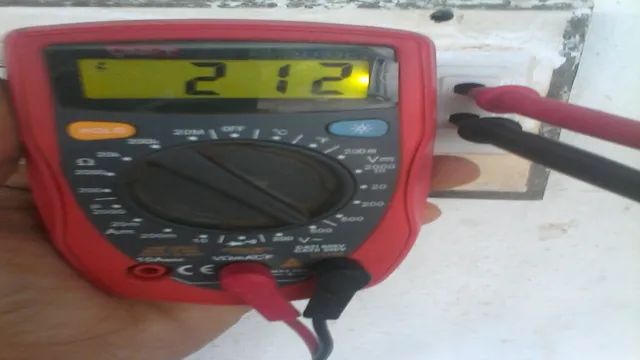As a homeowner or DIY enthusiast, you know that electricity can be dangerous and unpredictable. That’s why it’s essential to have the right tools for the job, and an AC voltage tester is undoubtedly one of them. But how exactly does it work, and why is it useful? In this blog post, we’ll dive into the world of using an AC voltage tester.
Whether you’re a complete beginner or have some experience with electrical work, this guide will provide you with all the information you need to safely and confidently use an AC voltage tester. So put your safety goggles on, and let’s get started!
What is an AC Voltage Tester?
An AC voltage tester is a simple device used to test whether there is electric current flowing through a specific circuit or outlet. This tool is essential for anyone working with electricity and helps to ensure safety while working. The process of how to use an AC voltage tester is relatively straightforward.
Start by turning off all power to the circuit you are working on by turning off the breaker at the circuit box. Next, insert the tester into the outlet or touch the tester to the wires, holding the tester with one hand, and ensuring that your other hand is not touching anything else. If the tester lights up or beeps, it is indicating that there is voltage present.
Ensure the circuit is off, and never touch anything that is energized with your bare hand. Overall, using an AC voltage tester can help prevent injury and ensure that electrical wiring is safe to work on.
Defining AC Voltage Tester
An AC voltage tester is a device that is used to detect the presence of electrical voltage in alternating current (AC) circuits. It is a handheld tool that is commonly used by electricians and DIY enthusiasts to check whether an electrical circuit is live or not. This tool works by detecting the magnetic field that is generated by the electrical current flowing through a wire.
When the tester is brought close to a live wire, it will light up and emit an audible alert to indicate the presence of voltage. This can help to prevent accidents and electrocutions when working with electrical circuits. It is important to note that an AC voltage tester should be used in conjunction with other safety measures, such as turning off power to the circuit before working on it.
In summary, an AC voltage tester is a simple yet essential tool that can help to ensure the safety of those working with electrical circuits.

Why Use an AC Voltage Tester?
An AC voltage tester is a tool that electricians use to measure the amount of voltage present in an alternating current (AC) electrical device or circuit. When you’re working with electricity, it’s important to know whether there is voltage running through a wire or device. This is where an AC voltage tester can come in handy.
By using an AC voltage tester, you can ensure that a wire or device is not electrified before you start working on it. This will help protect you from electric shocks and other injuries. An AC voltage tester is easy to use, and it can give you an accurate reading of the voltage in a matter of seconds.
It’s an essential tool for anyone who works with electricity, and it should be included in every electrician’s toolbox.
How to Use an AC Voltage Tester?
Using an AC voltage tester can be a bit intimidating for beginners, but with some basic knowledge, it can become an essential tool in diagnosing electrical problems. First and foremost, it’s important to make sure the device is calibrated and working properly before testing any electrical components. Then, simply turn off the power to the circuit being tested, insert the tester into the receptacle or touch it to the wire being tested, and wait for the reading.
The tester will indicate the level of voltage present, allowing you to determine if it’s safe to work on or troubleshoot further. Remember to always follow safety precautions and consult a professional if needed. So, if you’re wondering how to use an AC voltage tester, just be sure to take your time, follow the instructions, and be safe!
Safety Precautions Before Use
Before using an AC voltage tester, it is important to take certain safety precautions to avoid electric shocks or other accidents. One important step is to make sure that the tester is properly calibrated and working correctly before use. You should also check the voltage range of the tester to ensure that it can handle the voltage level you will be testing.
Make sure to wear appropriate personal protective equipment (PPE) such as gloves and safety glasses to protect yourself from electrical shock. It is also essential to switch off the power supply before testing any electrical equipment or outlets. Once you have taken these safety measures, you can then proceed to use the voltage tester.
Always follow the manufacturer’s instructions for use and testing procedures to ensure accurate readings. By taking the necessary precautions, you can safely use an AC voltage tester to test electrical components and ensure that they are functioning correctly.
Step-by-Step Guide
Using an AC voltage tester might sound daunting at first, but with a little guidance, it can become a straightforward process. Here’s a step-by-step guide to using an AC voltage tester. First, make sure the equipment is switched off and unplugged.
Second, insert the tester’s leads into the slots of the tester. Third, turn on the tester and set it to the voltage range needed for your project. Fourth, bring the tester near the wire you want to test and touch the lead probes to it.
Lastly, the tester will indicate if there is a voltage present, and the numbers or lights on the tester will tell you how much. It’s important to remember that AC voltage testers should only be used with the guidance of a professional electrician and appropriate safety precautions. With this in mind, using an AC voltage tester can help you complete your electrical projects with confidence.
Interpret the Results
An AC voltage tester is a valuable tool for anyone who needs to work with electrical systems. But, how do you use one? First, it’s important to understand that AC voltage testers can be dangerous if used improperly, so it’s crucial to read the manual and understand how to use it safely. Typically, you will need to insert the tester’s prongs into an electrical outlet or touch them to a wire.
Once the device is on, it will indicate whether the circuit is live or not. The results you receive will vary depending on the voltage of the circuit, but it’s essential to pay attention to the results. For example, a reading of zero usually means that the circuit is not live, while a reading above zero can indicate that the circuit is live.
It’s important to remember that an AC voltage tester won’t tell you what type of voltage you’re dealing with, so if you’re unsure, it’s best to call a professional electrician.
Conclusion
In conclusion, using an AC voltage tester is like putting on a detective hat for your electrical system. This nifty little tool allows you to snoop around and detect any mysterious voltage fluctuations, ultimately helping to solve the crime of faulty wiring. So grab your magnifying glass, plug in your AC voltage tester, and let’s get to the bottom of this electric mystery!”
Summary on AC Voltage Testers
If you need to test for the presence of AC voltage in an electrical system, an AC voltage tester can be a great tool to have on hand. To use this type of tester, first, make sure the device is working properly by testing it on a known source of voltage. Once you’ve confirmed that the tester is functioning correctly, you can proceed to test the circuit you are working on.
Begin by turning off the power to the circuit and then disconnecting any devices that are connected to it. Once the circuit is completely disconnected, turn the power back on and bring the tester close to each wire to check for AC voltage. If the tester indicates the presence of voltage, you will need to further investigate the source of the issue.
Remember to always wear appropriate safety gear and to consult a licensed electrician if you are unsure about anything you encounter during the testing process. Overall, using an AC voltage tester can help you identify potential problems in your electrical system and take steps to address them before they become more serious.
Tips and Tricks for Using AC Voltage Testers
If you’re new to electrical work, it’s important to know how to use an AC voltage tester. The first step is to choose the right tester for your needs – there are many different types available, ranging from simple pen-style testers to more advanced digital models. Once you have the right tester, it’s important to read the instructions carefully before you begin.
To use an AC voltage tester, you’ll need to first turn off the power to the circuit you’ll be working on. Then, you’ll need to touch the tester’s leads to the wires or terminals you want to test. If there is voltage present, the tester will light up or make a noise to alert you.
It’s important to note that voltage testers are only one part of electrical safety. Always wear protective gear like gloves and goggles, and make sure to follow proper wiring and circuitry guidelines. By following these tips and tricks for using an AC voltage tester, you can stay safe while working with electricity.
FAQs
What is an AC voltage tester?
An AC voltage tester is a device used to measure the presence and strength of alternating current (AC) voltage in electrical circuits and equipment.
How do you use an AC voltage tester?
To use an AC voltage tester, first make sure the equipment or circuit you want to test is turned off. Then, insert the tester’s probes into the outlet or circuit, and turn the power back on. The tester will indicate the presence of voltage with a light or sound, or on a digital display.
Can an AC voltage tester be used to test DC voltage?
No, an AC voltage tester is designed to measure only AC voltage. A separate device, such as a multimeter, should be used to test DC voltage.
What safety precautions should be taken when using an AC voltage tester?
Always wear rubber gloves and safety glasses when using an AC voltage tester. Make sure the equipment or circuit you are testing is turned off, and do not touch the probes with your bare hands. When testing electrical equipment, make sure it is properly grounded to avoid electrical shock.
What is the difference between a non-contact and contact AC voltage tester?
A non-contact AC voltage tester can detect the presence of voltage without actually touching the circuit or equipment being tested. A contact AC voltage tester requires physical contact with the circuit or equipment in order to measure the voltage.
Can an AC voltage tester be used to test voltage in outdoor electrical equipment?
Yes, as long as the tester is rated for outdoor use and is properly grounded. However, caution should always be taken when testing outdoor equipment, as weather conditions and other factors may affect the accuracy of the readings.
How often should an AC voltage tester be calibrated?
An AC voltage tester should be calibrated annually or according to the manufacturer’s recommendations, whichever comes first. Calibration helps ensure that the tester is accurately measuring voltage and is operating safely.






